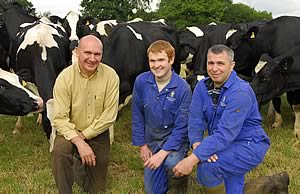| |
|
21/09/06
The Cheshire-based Hatton Heath herd, owned by Grosvenor Farms
and run by managing director Mark Roach, has won the UK dairy industry’s
most prestigious award – the NMR/RABDF Gold Cup.
Hatton Heath herd's Mark Roach, Rhys Evans herdsman,
Mark Farrall herd manager.
 |
A close runner-up and inaugural recipient of the NMR Silver Salver
is William Ley from Devon.
Both dairy herds have been finalists in the Gold Cup competition
in the past three years. This year they have risen to the top of
eight national finalists to take first and second place. The awards
were presented at the Dairy Event, today (September 20).
“Both dairy businesses met the philosophy of the competition,” said
Lyndon Edwards, chairman of the Gold Cup judges. “The Gold
Cup looks at all-round performance, spotlighting farm management,
environment policies and future planning strategies, as well as
investigating the production, health and welfare status of the
herd.”
The Hatton Heath herd, based at Alford near Chester, has earned
its winning place by making considerable progress during the past
few years. Mark Roach, along with herd manager Mark Farrall and
herdsman Rhys Evans, runs the 301-cow Holstein herd.
Previously a nucleus herd used for testing bull mothers for Cogent,
Hatton Heath is now managed on a totally commercial basis. “And
this has allowed us to concentrate solely on milk production and
is the reason we’ve been able to push yields up by around
1,000kg during the past year to the 11,000kg mark,” explains
Mark.
The herd’s average yield for the year ending September 2005
stood at 10,804kg of milk at 3.62% butterfat and 3.25% protein,
but by June 2006 this had risen to 11,089kg of milk at 3.67% butterfat
and 3.26% protein, with a SCC of 134,000 cells/ml.
Milk is currently sold to Wisemans, a decision made four years
ago that Mark says has paid off. “I think we made the best
move. We produce milk all year round and our flat production profile
is better suited to a liquid processor. Also, we’re ideally
located for supplying Liverpool and Manchester,” he says.
During the next five years expansion could also be on the cards,
but Mark is waiting for the right time. “The dairy business
has to become more profitable before we progress down this route,” he
says. “For now we will push the existing capital we have
as hard as possible and wait. We’ll manage costs as tightly
as possible and push yields.”
The dairy business has invested a lot of time and effort in conservation
and managing the farm environment. It has joined the Entry Level
Scheme and the Countryside Stewardship Scheme.
Runner-up
William Ley’s 380-acre farm, based at Sutcombe near Holsworthy
in Devon, is a family enterprise. His wife, Marion, and sons, Gerald
and Roland, each play a key role in the business – the core
of which is the renowned herd of Thuborough Holsteins.
The 180-cow herd now averages 10,945kg of milk at 3.98% fat and
3.30% protein on twice a day milking. Cell counts average 130,000/ml
and the herd has 20 cows that are classified Excellent.
Sons Gerald and Roland have diversified but kept the dairy herd
as the backbone of their enterprises. A bull-hire scheme run by
Gerald capitalises on the reputation of the herd and brings useful
supplementary income. Although never advertised, around 20 bulls
are out on hire at any one time, while those not used in the scheme – all
pure Holstein – are finished for bull beef.
Meanwhile, Roland was a driving force behind the establishment
of a scheme to share machinery, now used on every cattle farm in
the village of Sutcombe.
Back at base, William has explored the use of alternative products
on the farm, most notably ‘Digestate’, a by-product
of electricity generation, as an alternative to inorganic fertiliser.
Produced off-farm from his own herd’s (and others’)
slurry combined with traceable feed waste, the digested product
is stored in a massive six-million-litre tank on the farm and applied
just below the crop to the soil.
“Our fields have become a mass of clover,” says William, “and
we think the soil condition is much improved.” Wiping out
a £20,000 fertiliser bill is a further worthwhile benefit.
A philosophy of avoiding waste and making the very best of their
resources is followed by the Leys. “Ours is a very integrated
system and we want the whole farm to pay,” adds William.
All eight finalists in the Gold Cup 2006 were all presented with
certificates. As well as Mark Roach and William Ley, finalists
included Stephen and Catherine Temple from Norfolk, Ian and Sally
Macalpine from Lancashire, James Alston from Norfolk, Peter Jack
from Dorset, Chris May from Wiltshire, and Grenville and Libby
Wilson from Worcestershire.
Ian and Sally Macalpine won the Lilyhill Cup for the second year
running, awarded to the highest placed Jersey herd in the Gold
Cup competition.
* The NMR/RABDF Gold Cup is open to all milk recorded
herds meeting the competition criteria of more than 50 cows, a
rolling average cell count of less than 200,000/ml and a genetic
merit above the level set for the breed.
Finalists in the NMR/RABDF Gold Cup 2006 were judged by a panel
including: Lyndon Edwards, RABDF and chairman of judges; Philip
Kirkham, NMR Chairman and West Midlands dairy farmer; Richard Knight,
independent environmental consultant; Tim Dobson, dairy farmer
and RABDF council member; and Frank Armitage, Gold Cup coordinator.
 Eight Top Dairy Herds Go For Gold Eight Top Dairy Herds Go For Gold
 NMR/RABDF Gold Cup Turnout Up NMR/RABDF Gold Cup Turnout Up
 NMR/RABDF Gold Cup Qualifiers In North East And Yorkshire NMR/RABDF Gold Cup Qualifiers In North East And Yorkshire
 Gloucester
Dairy Farmer Takes Top Industry Trophy Gloucester
Dairy Farmer Takes Top Industry Trophy
|




